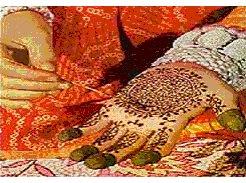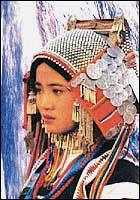Hello Everyone!
Fashion is an important aspect of all cultures. The world is getting smaller and more diverse. Behind each style is a meaning and history, what you could call a “masala” (mixture) of cultures. Understanding it is the key to recognizing the true beauty of each clothing creation.I am sure many of you are familiar with the fashion look this summer, which was bohemian. Actually, to be politically correct many of those styles are influenced by ancient Indian clothes that have been around for over thousands of years. For example, tunics are ancient Indian clothing called kurtas that are worn by men and women and come in various styles and lengths as well. Also, the long tiered "peasant" skirts are actually called “ghaghras” that are worn by Indian women of all ages throughout the country. These are just a few of the trends, but the following is a list of just a few more fashions that are originally from India and their meanings:

This picture is of Gwen Stefani and an Indian woman; they are both displaying the beauty mark called the “bindi”. It signifies the central point of the base of creation and acts as a resemblance of marriage in its traditional red color.


This picture is of Madonna wearing the traditional Indian temporary tattoo called mehendi. It is usually worn on the hands and feet of the woman and is particularly worn on the wedding day. Another neat little fact is that the mehendi mixture itself can be worn as a hair mask, and then rinsed out to give the hair natural red highlights.

As you can see, Jennifer Lopez’s couture green dress closely resembles the draping of a sari. Did you know that the sari dates back to
3000 B.C?! Before tailoring was even created, the sari created an illusion of form-fitting clothing to accentuate certain areas of a woman’s figure. In India the idea of beauty was to have a small waist and large hips and bust. The sari was created and wrapped in such a way that it exposes the waist and accentuates the waist and the bust with the pleated bottom of the fabric so it can reflect the ideal shape to any figure.

The paisley design has become a classic design in our clothing. However, this design did originate in India, originating in India long back. The design was usually found on Indian shawls made of silk and cotton. They became popular during the 19th century continued British invasion of India; as soldiers would send shawls back home.
I am going to elaborate more on these influences on fashion later. These cultural exchanges in fashion go both ways, with western fashion influencing all parts of the globe. For example, most sports in the world today have players wearing western clothing. But, all cultures are not taking it very well. Did any of you hear about the upcoming tennis player Sania Mirza? Well, the story goes like this…this girl happened to reach the fourth round of some major tennis tournament (in a country where tennis is not a popular sport), but that’s not what caused all the uproar. She actually had a “fatwa” (a legal pronouncement in Islam) issued against her for wearing a skirt while playing tennis. I was appalled when I heard this, how unfair!! What do you guys think about this? For the complete story click on this link:
http://www.telegraph.co.ukReferences:
1. Adam, Sunil. May 01, 2003. Trampling on Hindu Sentiments - Footwear with Ganesha Images. India-west <http://news.ncmonline.com/news/view_article.html?article_id=66b10da4b2bb6bcdf22324495852dc1f>2. Anand Jon. [On-line]. 2002. Anand Jon Ellemans, Inc. http://www.anandjon.com/3. History and significance of a Bindi. [On-line]. 2003. http://www.pardesifashions.com/4. History of a Sari. [On-line]. 2003. http://puja.com/sari/hstry/hstry.htm5. Journal of Indian Philosophy. “Maitreya‘s Jewelled World: Some Remarks on Gems and Visions in Buddhist Texts” 26 (4): 347-371, August 1998 Copyright © 1998 Kluwer Academic Publishers.6. Om kara mantras. [On-line]. 2003. http://www.vydic.org/pages/slok_framset.htmPuri, Sunita. “'Ethnic fashion' obscures cultural identity.” [On-line]. 2001.
7. The Yale Herald, http://www.yaleherald.com/







